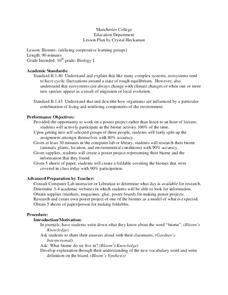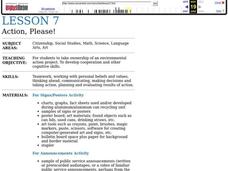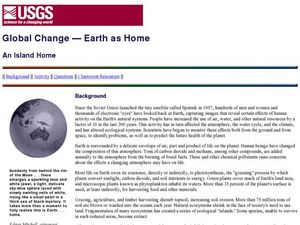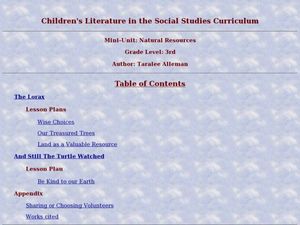Curated OER
Discovering National Parks
Students work to preserve American National Parks. In this environmental activism lesson plan, students research the history of the national parks and determine why they were created. Students then focus on protecting the land, using it...
Curated OER
Now You Have It, Now You Don't
Sixth graders compare corn-based shipping peanuts to Styrofoam shipping peanuts. In this hands-on environmental awareness lesson plan, 6th graders try dissolving two different types of packing peanuts in water.
Curated OER
Artscapes
Students consider "The Gates" and other environmental art projects, and create an original public art project for their local community. They draw sketches and write proposals outlining their ideas.
Curated OER
Water: Our Most Important Beverage
Third graders create a KWL chart about water. In this environmental science lesson plan, 3rd graders demonstrate how much water on Earth is usable. They act out the different stages of the water cycle.
Curated OER
Be a Weather Newscaster
Ninth graders, in groups, create and videotape a news broadcast. Each group researches, develops and writes a weather forecast, a commentary on an environmental concern, a school activity and a commercial.
Curated OER
Debate: "Indoor Air vs. Outdoor Air Pollution: Which Is the More Serious Threat to Public Health?"
Students work in teams to synthesize their air, asthma, air contamination, and environmental health knowledge as well as additional research to represent a particular point of view persuasively. They create a handout and presentatin...
Curated OER
Honey, I Shrunk the Lids!
Young scholars discover the lightweighting concept used by manufacturers. In this environmental education lesson, students research the reduction of the amount of aluminum used in cans. Young scholars wrap the lesson up by writing a...
Curated OER
Why Eat Organic?
Ninth graders explore the concept of organic eating. In this environmental stewardship lesson, 9th graders compare and contrast organic foods with conventional foods and discuss the benefits of eating organic foods.
Curated OER
Biomes
Tenth graders research locations of biomes and their barriers. In this biomes lesson, 10th graders examine location, environmental conditions, and species of plants and animals that live in the biome. Students take notes and create a...
Curated OER
The Case of the Broken Loop
In this environmental awareness instructional activity, students complete 8 pages pertaining to waste, landfills, recycling and composting. Included are: matching words and definitions, crossword puzzle, scrambled letters, a code, word...
Curated OER
Energy Sources
Students identify natural resources and describe the difference between renewable and non-renewable resources. They also identify the disadvantages and advantages of the resources.
Curated OER
Reduce, Reuse and Recycle
Students explore the concept of waste management. In this environmental stewardship lesson, students study the nuances of the terms reduce, reuse, and recycle. Students investigate ways to reduce, reuse, and recycle many everyday items...
Curated OER
Action, Please!
Students create an advertising campaign. In this environmental education lesson, students research aluminum and aluminum can recycling. Students wrap the lesson up by writing newspaper articles, creating public service announcements, and...
Curated OER
Environmental Problems and Solutions
In this environmental problems and solutions worksheet, learners are given a list of 25 environmental problems. They match them with a given solution and paste the matching pairs to a piece of construction paper.
Curated OER
Global Change- Earth as Home
Students create their own environment. In this environmental protection instructional activity, students pretend they are the owners of a tropical island. They create jobs for the citizens and develop the island as a model environment.
Curated OER
The Human Footprint
In this environmental stewardship lesson, students view the human footprint website and then answer 3 short answer questions related to human impact on the earth.
Curated OER
Trash Inventions
Second graders develop a plan to recycle trash. In this environmental science lesson, 2nd graders sketch their invention and construct it. They present the final product in class.
Curated OER
It's Goin' Down; The Rain Forest
Students discover the global problem of deforestation. In this environmental lesson plan, students identify organizations on the quest to stop deforestation. Students also discover what they can do to solve this global dilemma.
Curated OER
Is That Natural?
Students examine how they use and waste natural resources. They participate in a class discussion about natural resources, in small groups complete a worksheet identifying ways students misuse natural resources, and create an...
Curated OER
Environmental Issues
For this environmental issues worksheet, students are given 10 current topics that are problems in our environment today. They complete sentences about each topic by filling in the blanks with the appropriate terms. Some of the issues...
Curated OER
Integrating Environmental Science: Plastics
In this plastics instructional activity, students read about the uses of plastics and their environmental impact. Students answer questions about plastics and their use.
Curated OER
The Lorax
Third graders identify environmental problems. In this natural resources lesson students participate in several activities that support critical thinking about the environment and natural resources. The students write, list, and verbally...
Curated OER
Conservation at a Crossroads Lesson 1: What Is Conservation and Why Does It Matter?
Students explore the concept of conservation. In this conservation lesson, students read articles and primary documents about the Conservation Movement in the United States and compare the movement to today's environmental movements....
Curated OER
What Have We Done?
Students investigate the effect of dams on the ecosystem. In this environmental instructional activity, students read case studies on the Aswan Dam and the Colorado River Basin and construct a T-chart to compare the effects on the region.























